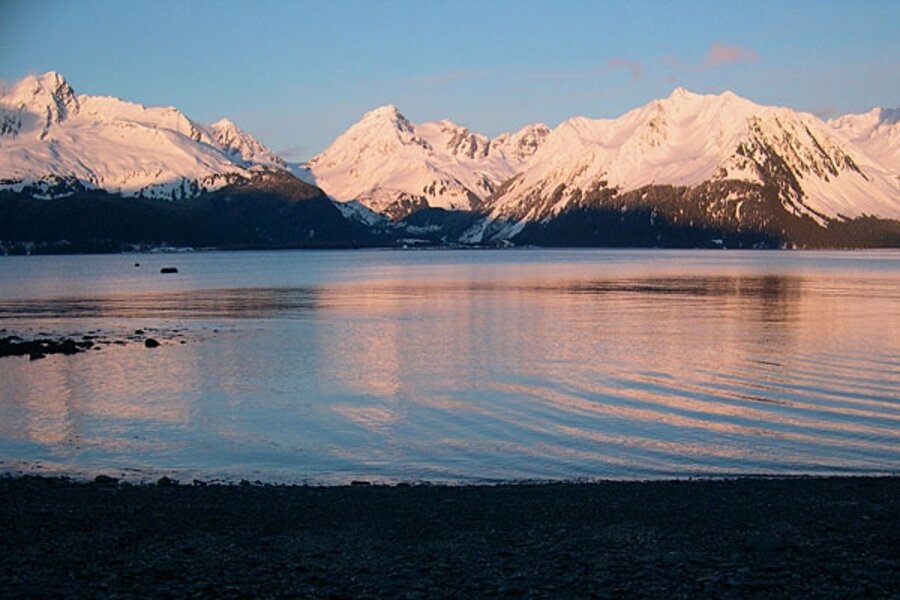Carbon emissions increasing acidity in Alaskan seas
Loading...
| Seward, Alaska
Beneath the sparkling waters of Resurrection Bay, where rich runs of salmon support thriving commercial fish harvests and humpback whales can be seen breaching just offshore in summertime, Jeremy Mathis sees signs of the way greenhouse gases are changing the world's oceans.
For years, scientists have presented mounting evidence that carbon dioxide emissions are contributing to a change in global climate – raising temperatures, melting polar ice, and perhaps fueling extreme weather. For Dr. Mathis, it is clear that these emissions are also having an effect beneath the waves.
In short, they are turning seawater more acidic. Ocean acidification is often called the twin of climate change. Just as increased carbon in the atmosphere triggers effects that change the climate, increased carbon in the atmosphere – when absorbed by the oceans – triggers acidification in the water.
At this point, the effects are subtle – a small dip in the waters' pH balance, and a gradual depletion of the minerals that make Alaskan waters so productive for sea life. Indeed, the very characteristics that help make Alaskan waters so rich – the cold temperatures that hold more carbon and shallow waters saturated with nutrients – also make them more susceptible to acidification, experts say.
As with climate change – which has already thawed permafrost, melted sea ice, and shrunk glaciers in Alaska – carbon-caused ocean acidification will likely hit home here first.
"Waters off Alaska are sort of preconditioned to become more acidified," says Mathis, a University of Alaska, Fairbanks, oceanographer.
Two-centuries-old trend
During the past two centuries, the oceans have absorbed one-quarter of the carbon dioxide emitted into the atmosphere by human activities, according to the United Nations' Intergovernmental Panel on Climate Change (IPCC). While that has helped to lessen the impact of carbon dioxide emissions on the climate, it has been at a cost. This carbon dioxide - the same gas that makes fizzy beverages corrosive – is altering the oceans' alkaline-acid balance, known as pH.
The average pH levels in the world's oceans have dropped from 8.21 at the start of the Industrial Age (in the late 18th century) to an average 8.1 on the 1-to-14 scale, according to the IPCC. Changes will be more dramatic in coming years, the IPCC warns. Average pH levels are expected to decrease by as much as 0.4 by the end of the century, continuing the move in the acidic direction, the committee says.
Mathis and his fellow researchers are trying to understand how – and when – these changes might affect Alaska. They are making spring and fall voyages into the Bering Sea, Arctic Ocean, and Gulf of Alaska to analyze the contents of water retrieved from capsules plunged into the water column.
He cannot yet assign a specific average pH value to Alaskan waters, but other data show a clear trend line.
One indicator is the levels of calcium and aragonite. The minerals are fundamental to Alaska's offshore ecosystems. Shell-bearing animals such as king crabs and pteropods – small shell-encrusted creatures that make up the bulk of salmon's diet in the ocean – depend upon calcium carbonate. [Editor's note: Pteropods was misspelled in the original version.]
In undersaturated zones, the calcium- and aragonite-poor water effectively robs those elements from the shells that sea creatures are trying to form. In general, the deeper the layer of saturation, the better for the fish.
Aragonite saturation in the Gulf of Alaska, of which Resurrection Bay is a part, has traditionally extended down to 250 meters, Mathis says. Calcium saturation in the gulf has reached down to about 500 meters, he says. But his data are showing that undersaturated waters are creeping up higher.
"The more man-made carbon dioxide we put into the ocean, the shallower those saturation points will become," says Mathis.
Effects of acidification are not obvious enough to be noticed by a casual observer.
"It's not like you're going to see something washed up on the beach with a dissolved shell," says Bob Foy, director of the National Oceanic and Atmospheric Administration's fisheries research laboratory in Kodiak, Alaska.
The effects of acidification
But his research has found that king crabs raised in incrementally more acidic water grow shells more slowly and have higher mortality rates. What will happen, he suggests, is that animals dependent on calcium carbonate will be more stressed and have greater difficulty with development and reproduction, and might even migrate away. Pteropods are particularly vulnerable, he says. [Editor's note: Pteropods was misspelled in the original version.]
"That's going to impact whole food chains. Maybe it already is. We just don't know," he says.
For commercial fishermen in Alaska, who harvest more than half the nation's seafood catch, the specter of acidification is worrying.
"If you really care about fish – not only to make money but also to eat and feed people – it's of grave concern," says Alan Parks of nearby Homer, who has been fishing commercially for three decades and also works for the environmentally minded Alaska Marine Conservation Council.
---
See also:
Agreement on climate change looks unlikely ahead of Copenhagen
Amid charges of global warming hoax, new warning on climate change
Climate change: Are women the solution?
---
Follow us on Twitter: @CSMNational





